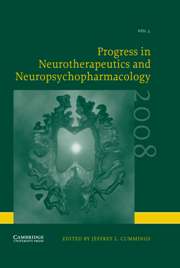Article contents
Insulin Resistance Alzheimer's Disease: Pathophysiology and Treatment
Published online by Cambridge University Press: 06 December 2007
Extract
ABSTRACT
Insulin and insulin resistance likely play a significant role in the pathophysiology and cognitive decline associated with Alzheimer's disease (AD). Insulin, insulin receptors, and insulin-sensitive glucose transporters are selectively localized the brain, including medial temporal areas that support memory. Raising brain insulin levels can facilitate memory and increase cerebrospinal fluid levels of β-amyloid (Aβ) and inflammatory markers. Insulin's effects on cognition may reflect normal regulation of glucose metabolism, long-term potentiation, and neurotransmitter levels. Consequently, insulin abnormalities may disrupt normal memory functioning and promote pathophysiological processes observed in patients with neurodegenerative disorders. Conversely, restoring normal insulin activity may exert a beneficial effect on pathophysiological processes. For example, peroxisome proliferator-activated receptor (PPAR)-gamma agonists (insulin sensitizing agents used to treat type 2 diabetes mellitus) modulate neuronal cell survival, inflammatory responses, mitochondrial functioning, and possibly Aβ processing and deposition. One PPAR-gamma agonist, rosiglitazone, facilitates memory and modulates plasma Aβ levels in patients with AD. Likewise, a healthy diet and regular exercise may improve insulin sensitivity and decrease the risk for both AD. Furthermore, intranasal insulin administration rapidly delivers insulin to the brain without altering plasma insulin or glucose levels. Studies to date suggest that this procedure can facilitate memory and modulate plasma Aβ levels in memory-impaired adults. Interestingly, the adverse effects of insulin abnormalities and the beneficial effects of improving insulin sensitivity may differ by apolipoprotein E (APOE) genotype, an established risk factor for AD. Patients who do carry lower doses of the APOE e4 allele have an enhanced risk for insulin abnormalities and are also more responsive to the memory enhancing effects of both rosiglitazone and intranasal insulin administration, relative to other patients. Therefore, future therapeutic trials should consider the moderating effects of APOE genotype.
Keywords
- Type
- Research Article
- Information
- Progress in Neurotherapeutics and Neuropsychopharmacology , Volume 3 , Issue 1 , January 2008 , pp. 85 - 110
- Copyright
- © 2008 Cambridge University Press
References
- 1
- Cited by




